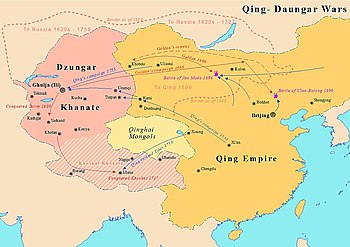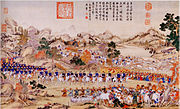Dzungar–Qing Wars
| Dzungar–Qing Wars | |||||||||
|---|---|---|---|---|---|---|---|---|---|
 The Dzungar army surrenders to the Qing dynasty after Dawachi being captured in 1756.[1] | |||||||||
| |||||||||
| Belligerents | |||||||||
| Dzungar Khanate | |||||||||
| Commanders and leaders | |||||||||
|
Galdan Boshugtu Khan Tsewang Rabtan Amursana | |||||||||
The Dzungar–Qing Wars (Mongolian: Зүүнгар-Чин улсын дайн, simplified Chinese: 准噶尔之役; traditional Chinese: 準噶爾之役; pinyin: Zhǔngá'ěr zhī Yì; lit. 'Dzungar Campaign') were a decades-long series of conflicts that pitted the Dzungar Khanate against the Qing dynasty and its Mongol vassals. Fighting took place over a wide swath of Inner Asia, from present-day central and eastern Mongolia to Tibet, Qinghai, and Xinjiang regions of present-day China. Qing victories ultimately led to the incorporation of Outer Mongolia, Tibet and Xinjiang into the Qing Empire that was to last until the fall of the dynasty in 1911–1912, and the genocide of much of the Dzungar population in the conquered areas.
Background
After the collapse of the
The Khalkha rulers, defeated, fled to Hohhot and sought Qing assistance.[7] Meanwhile, the Qing had secured a peace treaty with the Cossacks on their northern border, who had previously been inclined to support Galdan. The Treaty of Nerchinsk prevented an alliance between Galdan and the Russians, leaving the Qing free to attack their Mongol rivals.[8] Fearing a united Mongol state ruled by the hostile Dzungars, the Qing now turned their powerful war machine on the Oirats.[9]
The Dzungars had conquered and subjugated the Uyghurs during the Dzungar conquest of Altishahr after being invited by the Afaqi Khoja to invade the Chingisid Chagatai ruled Yarkent Khanate. Heavy taxes were imposed upon the Uyghurs by the Dzungars, provoking resentment.[10] This led to uprisings and Uyghur rebels from Turfan and Kumul who were rebelling against Dzungar rule joined the Qing in their war against the Dzungars. The Yarkent Khanate under Muhammad Amin Khan presented tribute to the Qing dynasty twice to request aid against the Dzungar attack.[11]
The Dzungars used the Zamburak, camel mounted miniature cannons, in battle, notably at Ulan Butung.[12] Gunpowder weapons like guns and cannons were deployed by the Qing and the Dzungars at the same time against each other.[13]
First Dzungar-Qing War
| First Dzungar – Qing War | |||||||
|---|---|---|---|---|---|---|---|
 Military camp of the Chinese Emperor at Kherlen River during the campaign of 1696 | |||||||
| |||||||
| Belligerents | |||||||
| Dzungar Khanate |
| ||||||
| Commanders and leaders | |||||||
| Galdan Boshugtu Khan |
Kangxi Emperor Chakhundorji Abdullah Beg | ||||||
| Strength | |||||||
| 20,000–30,000[14] | 100,000[14] | ||||||
| Casualties and losses | |||||||
| Unknown | Unknown | ||||||
The First Dzungar–Qing War was a military conflict fought from 1687 to 1697 between the
Qing scouts attacked a Dzungar party north of the Great Wall. However, this proved to be the main Dzungar army, which destroyed the Qing detachment easily.
A pause in the conflict ensued. The Khalkha rulers declared themselves Qing vassals at
After the war, a Qing garrison was stationed in the area of present-day Ulaanbaatar, and Khalkha Mongolia was placed under Qing rule. Outer Mongolia was effectively incorporated into the Qing Empire. On the other hand, Tsewang Rabtan, a long-time anti-Galdan Oirat chief, who had actually provided intelligence to the Qing[9] at several points during the war, succeeded Galdan as Khan of the Dzungars. While the Qing managed to sideline the Dzungar in the 1690s, they would not completely eradicate them until they defeated the Dzungars in subsequent wars several decades later.[24]
Second Dzungar–Qing War, in Tibet

In 1642,
Jalangga, a Manchu Bannermen, succeeded the Han General Yue Zhongqi as commander in 1732.[31]The Manchu
Third Dzungar–Qing War
In 1723, the
The Oirats were fought by Yue Zhongqi in Ürümqi.[29][30][33] Yue Zhongqi lived at the Ji Xiaolan Residence.
Final conquest of the Dzungars

In 1752,
Amursana now rallied the majority of the remaining Oirats to rebel against Qing authority. In 1758, General Zhaohui defeated the Dzungars in two battles: the
-
Zhaohui receives the surrender of Dawachi at Ili, 1755. Painting by Jesuit painter at the Qing court, Ignatius Sichelbart.
-
"Storming of the Camp at Gädän-Ola", a scroll depicting a raid in 1755 in which the Kalmuk Ayusi, having gone to the Chinese side, attacks Dawa achi's camp on Mount Gadan. Painting by Giuseppe Castiglione.
-
The Battle of Oroi-Jalatu, 1756. Chinese general Zhao Hui attacked the Zunghars at night in present Wusu, Xinjiang. Painting by Giuseppe Castiglione.
-
"The Victory of Khorgos". The partisans of Amursana were defeated in 1758 by Prince Cäbdan-jab. Painting by Jean Denis Attiret.[34]
-
Battle of Khurungui, 1758. General Zhao Hui ambushes and defeats the Zungarian forces of Amoursana on Mount Khurungui (near Almaty, Kazakhstan). Painted by Jean-Damascène Sallusti.
See also
References
- ^ "平定准噶尔图卷". 中国国家博物馆.[permanent dead link]
- ISBN 978-0-520-07124-7.
- ^ "昭莫多之战:康熙亲征获胜,噶尔丹服毒自杀_中国历史网". Archived from the original on April 11, 2023. Retrieved May 1, 2016.
- ^ "Archived copy". Archived from the original on August 22, 2017. Retrieved May 1, 2016.
{{cite web}}: CS1 maint: archived copy as title (link) - ISBN 978-0-8135-3533-3.
- ^ Peter C. Perdue, China Marches West:The Qing Conquest of Central Asia, pg. 149
- ^ New Qing Imperial History:The Making of an Inner Asian Emire at Qing Chengde, Ruth W. Dunnell, Mark Elliot, James A. Millward, pg. 99
- ^ The Tea Road:China and Russia Meet Across the Steppe, pg. 106, Martha Avery
- ^ a b c The Sichuan Frontier and Tibet:Imperial Strategy in the Early Qing, 44,45, Yincong Dai
- ISBN 978-92-3-103876-1.
- ISBN 9231038761. Retrieved April 22, 2014.
- ^ Millward 2007, p. 89.
- ^ Haines, Spencer (2017). "The 'Military Revolution' Arrives on the Central Eurasian Steppe: The Unique Case of the Zunghar (1676 - 1745)". Mongolica: An International Journal of Mongolian Studies. 51. International Association of Mongolists: 170–185.
- ^ a b History of the Civilizations of Central Asia, Vadiam Mikhailovich Masson, pg. 148
- ^ Haines, R Spencer (2015). "Myth, Misconception, and Motive for the Zunghar Intervention in Khalkha Mongolia in the 17th Century". Paper Presented at the Third Open Conference on Mongolian Studies, Canberra, ACT, Australia. The Australian National University.
- ^ Peter C. Perdue, China Marches West:The Qing Conquest of Central Asia, 153
- ^ The Cambridge History of China, Willard J. Peterson, pg.154
- ^ Historical Dictionary of Mongolia, Alan Sanders, pg. 288, Scarecrow Press
- ^ J. Millward, Eurasian Crossroads:A history of Xinjiang, pg. 91
- ^ Peter C. Perdue, China Marches West:The Qing Conquest of Central Asia,177-180
- ^ Wars in the Age of Louis Xiv, 1650-1715, C.J.Nolan, p.g. 224
- ISBN 978-0810879843.
- ^ Peter C. Perdue, China Marches West:The Qing Conquest of Central Asia,148- 189
- ^ Haines, R Spencer (2016). "The Physical Remains of the Zunghar Legacy in Central Eurasia: Some Notes from the Field". Paper Presented at the Social and Environmental Changes on the Mongolian Plateau Workshop, Canberra, ACT, Australia. The Australian National University.
- ^ René Grousset, The Empire of the Steppes, New Brunswick 1970, p. 522
- ^ Mullin 2001, p. 288
- ^ Mullin 2001, p. 290
- ^ Smith 1997, p. 125
- ^ ISBN 978-0-674-04202-5.
- ^ ISBN 978-0-674-04202-5.
- hdl:10822/761498.
- ISBN 978-0674042025.
- hdl:10822/761498.
- ISBN 978-1-60606-457-3.




!["The Victory of Khorgos". The partisans of Amursana were defeated in 1758 by Prince Cäbdan-jab. Painting by Jean Denis Attiret.[34]](http://upload.wikimedia.org/wikipedia/commons/thumb/0/04/The_Victory_of_Khorgos1.jpg/180px-The_Victory_of_Khorgos1.jpg)
